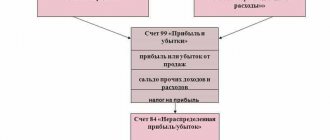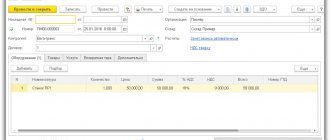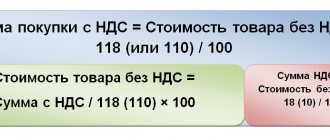Legislation: Procedure for carrying forward losses from previous years
The Tax Code provides for the possibility of reducing the tax base for income tax by the amount of losses incurred in previous tax periods.
Carrying forward losses to the future is possible both based on the results of the reporting period (1st quarter, 1st half of the year, 9 months) and based on the results of the tax period (Letter of the Ministry of Finance of the Russian Federation dated 03.08.2012 N 03-03-06/1/382, Letter of the Ministry of Finance of the Russian Federation dated 16.01 .2013 N 03-03-06/2/3).
From January 1, 2017 to December 31, 2020, the tax base for the tax for the current reporting (tax) period cannot be reduced by the amount of losses from previous years by more than 50% (clause 2.1 of Article 283 of the Tax Code of the Russian Federation).
For taxpayers who have a special status and apply special tax rates in accordance with the Tax Code of the Russian Federation, the loss can be written off without taking into account the specified limitation, i.e. in full:
- residents of a technology-innovative special economic zone, as well as resident organizations of tourist and recreational special economic zones, united by a decision of the Government of the Russian Federation into a cluster (clause 1.2 of Article 284 of the Tax Code of the Russian Federation);
- participants in regional investment projects (clause 1.5, clause 1.5-1 of Article 284 of the Tax Code of the Russian Federation);
- participants of the free economic zone (clause 1.7 of Article 284 of the Tax Code of the Russian Federation);
- residents of territories of rapid socio-economic development (clause 1.8 of Article 284 of the Tax Code of the Russian Federation);
- residents of the free port of Vladivostok (clause 1.8 of Article 284 of the Tax Code of the Russian Federation);
- participants of the Special Economic Zone in the Magadan Region (clause 1.10 of Article 284 of the Tax Code of the Russian Federation);
- residents of the Special Economic Zone in the Kaliningrad Region (clause 6 and clause 7 of Article 288.1 of the Tax Code of the Russian Federation).
There is no time limit on the transfer of losses; the transfer is made until the resulting loss for all previous years is completely written off.
If losses are received in more than one tax period, then the transfer is carried out in the order in which they were incurred (clause 3 of Article 283 of the Tax Code of the Russian Federation).
The entire time the taxpayer is transferring a loss, he is obliged to keep primary documents confirming its occurrence (clause 4 of Article 283 of the Tax Code of the Russian Federation). After the end of the transfer, such documents must be stored for another 4 years (clause 8 of clause 1 of Article 23 of the Tax Code of the Russian Federation ).
Assessing financial results: stages and indicators
It is important to understand: there are no hard and fast rules in financial analysis. This means that the analyst always chooses the calculation method and the set of both initial and final indicators himself. Therefore, our approach is approximate. In it, we focused primarily on Russian reporting. It does not have ready-made indicators of marginal profit, EBITDA, NOPAT, etc. They will not be in our stages and examples.
We offer step-by-step instructions on how to make a financial analysis of an enterprise in terms of financial results.
Stage 1. Conduct a horizontal analysis of profit (loss)
The essence of horizontal analysis is to understand how the financial result has changed compared to the previous period. Here are some of its features:
- you will need at least two profit (loss) values. One of them is taken as the basis for comparison. Typically this is a value from the earliest time period;
- either absolute or relative deviations of the actual level from the base level are calculated. To calculate the latter, formulas for growth rates and increments are useful. See them in table 1;
- absolute deviations are measured in the same unit as the analyzed indicator. In our case it will be rubles. Relative – either as a percentage or as a share;
- if the indicator in the base period was zero or had a different sign than in the current one, then the growth/increase rates will either not be calculated or they will not make sense. For example: in 2021 the organization received 1 million rubles. loss, and in 2021 – 2 million rubles. arrived. The growth rate is: 2 ÷ (-1) × 100% – 100% = -300%. If interpreted literally, it will turn out like this: the financial result for the year decreased by 300%. Agree, this is stupidity;
- the nature of the change (positive, negative) does not depend on the sign of the resulting deviation. It is determined by the meaning of the indicator itself. For example, growth and, therefore, positive deviations are important for income or profit. For expenses and losses, on the contrary, they are negative.
Table 1.
Deviation formulas for horizontal analysis
| Indicator name | Formula | |
| Absolute deviation | N1–N0 | |
| Relative deviations | Growth rate | N1 ÷ N0 × 100% |
| Rate of increase | (N1 – N0) ÷ N0 × 100% | |
| Note: N0, N1 – values of the analyzed indicator in the base and current periods | ||
Stage 2. Perform a vertical analysis of the financial results of the enterprise
Vertical analysis consists of calculating the specific weight of any indicator in the total sum of homogeneous values. Otherwise, it is an assessment of the structure in which a separate element is correlated with a certain whole of which it is a part.
This approach has a unique feature for all indicators from the financial results statement, since it is not immediately clear what is considered the whole into which the partial values will be divided. Reason: the report is based on the principle of subtraction, not summation, unlike the balance sheet.
Therefore, we propose to implement vertical analysis in two directions:
- for retained earnings from the balance sheet, calculate its share in equity and/or liabilities. This will make it possible to understand how significant the contribution of the accumulated result is to the total amount of sources of financing the enterprise’s activities;
- for other types of profit from the income statement, correlate their value with income. Moreover, for gross profit and sales, calculate the ratio with revenue. For profit before tax and net – with the amount of revenue and other income. Rationale: this way we will make a comparison with those incomes that took part in the calculation of a specific type of financial result. What will these calculations show? What amount of earned income remains with the enterprise at each stage of profit formation. Indirectly, this is a characteristic of the significance of the expenditure part, because the lower the share, the more expenses there are for each ruble of income.
It is important to remember: vertical analysis is meaningless for loss indicators.
Here is the formula for calculating specific gravity:
Ni = ∑Ni × 100%,
where Ni is the value of a specific indicator (part);
∑Ni is the value of the general indicator, which includes Ni as a component element (whole).
Absolute values of financial results have a big drawback: a low degree of comparability with other organizations. This is true even if the financial statements of enterprises of the same type of activity are examined.
Stage 3. Calculate profitability indicators
Absolute values of financial results have a big drawback: a low degree of comparability with other organizations. This is true even if the financial statements of enterprises of the same type of activity are examined. For example, a federal retail chain’s ruble profit will easily be many times higher than that of a local store. However, its ratio to the value of assets, equity or revenue may show a different picture - not at all in favor of the trading giant.
Such relationships between the values of the financial result and other indicators of the organization’s activities are called profitability. Their undoubted advantage is the opportunity to compare initially disparate absolute values.
Here are a few features that are characteristic of such relative quantities:
- There is a basic calculation scheme. Its essence: the numerator is always profit, the denominator is the indicator whose profitability is calculated. Most often these are: assets, equity and revenue. But nothing prevents us from putting only non-current or current assets, liabilities or borrowed funds into the denominator. The specific names of the indicators are determined by the denominator. For example, return on assets, equity, sales, etc.;
- What kind of profit should be used in the numerator? Decide for yourself. More often than others, net and from sales are used;
- if the denominator of the formula contains a balance sheet indicator, then its average annual value is taken, and not just the value as of the date. Why? Because the profit from the numerator is the financial result that is obtained for the period. It is incorrect to combine periodic and point values when calculating. A reasonable solution: turn what happened on the date into what was on average for the year. Not the most accurate, but the easiest way to do this is to sum up the halves of the values at the beginning and at the end of the year. Remember: in the balance sheet, all data is presented at the end of the period, for example, as of December 31, 2019. They can be regarded as the value at the beginning of the next year, that is, as of January 1, 2020;
- How is profitability measured? Standard practice is percentages. Less often – fractions of units. And very rarely, but also acceptable - rubles for rubles. For example, for return on assets, calculated based on net profit and equal to 10%, the interpretation will be as follows: for every ruble invested in assets, there is a return in the form of 10 kopecks of net profit;
- It is incorrect to call profitability those indicators whose numerator is a loss. More correctly – unprofitability. In this case there will be no contradiction with the original meaning of the word “rent”.
See Table 2 for the formulas for the main profitability indicators. In the following example we will use just such a set.
Table 2.
Relative indicators for assessing financial results
| Index | Formula | |
| by net profit | by sales profit | |
| Return on assets | Emergency ÷ Asr. × 100% | PP ÷ Asr. × 100% |
| Return on equity | Emergency ÷ SKsr. × 100% | PP ÷ SKav. × 100% |
| Return on debt capital | Emergency ÷ ZKsr. × 100% | PP ÷ ZKsr. × 100% |
| Return on sales | PE ÷ V × 100% | PP ÷ V × 100% |
Note:
| ||
Stage 4. Assess the impact of individual factors on the financial result
Factor analysis of financial results can be implemented in two directions:
- by absolute values of profit (loss);
- by relative values, that is, by profitability.
Let's look at the formulas for each of them.
Suppose: the analyst has nothing at his disposal except the financial statements of the enterprise. He does not have data on price, sales volume and operating profit for a specific product item. Then the following factor analysis formula will be optimal:
PP = B – SP – KR – UR,
where SP is the cost of sales (2120 OFR);
KR – commercial expenses (2210 OFR);
UR – administrative expenses (2220 OFR).
With its help, the influence of four factors (in the formula on the right) on the value of the financial result is assessed.
The peculiarity of the formula: to calculate the factor influence using it, there is no need to use any special techniques. When factors are linked through an algebraic sum, it is enough to calculate the absolute deviation of each to understand what its impact on the financial result was.
There are many models for factor analysis of profitability. Let's focus on the most popular - the DuPont model. Here is its three-factor formula:
Rsk = Rp × Koa × MK,
where Rsk is return on equity;
Рп – profitability of sales;
Koa – asset turnover ratio (B ÷ Asr.);
MK – equity multiplier (Avr. ÷ SKr.).
To assess the impact of three factors on return on equity, we apply the absolute difference method. Table 3 contains ready-made formulas for this DuPont model.
Table 3.
How to calculate the influence of factors in the DuPont three-factor model
| Factor | Formula for assessing its influence |
| Return on sales | ∆Рс (Рп) = ∆Рп × Koa 0 × MK 0 |
| Asset turnover ratio | ∆Rsk (Koa) = Rp 1 × ∆Koa × MK 0 |
| Equity multiplier | ∆Рsk (MK) = Рп 1 × Koa 1 × ∆МК |
Note:
| |
If everything is calculated correctly, then the absolute change in Rsk and the total impact of factors will be equal:
Rsk = ∆Rsk (Pp) + ∆Rsk (Koa) + ∆Rsk (MK).
Transfer of losses to 1C 8.3 step by step, postings
Based on the results of 2021, the Organization received a loss in the amount of RUB 520,000. The organization decided that the loss received at the end of the year will reduce the profit of subsequent years.
In the 1st quarter of 2021, the Organization made a profit of RUB 800,000. The tax base for income tax is reduced by the amount of loss received in 2021 in the amount of 50%, i.e. taking into account the restrictions in clause 2.1 of Art. 283 Tax Code of the Russian Federation.
Let's consider the transfer of losses in 1C 8.3 step by step postings. PDF
| date | Debit | Credit | Accounting amount | Amount NU | the name of the operation | Documents (reports) in 1C | |
| Dt | CT | ||||||
| Reporting tax period | |||||||
| Closing the tax period | |||||||
| 31th of December | 99.01.1 | 90.09 | 520 000 | 520 000 | 520 000 | Determination of financial results | Closing the month - Closing accounts 90.91 |
| Carry forward of loss to future periods | |||||||
| 31th of December | 97.21 | 99.01.1 | — | 520 000 | 520 000 | Carry forward of loss to future periods | Manual entry - Operation |
| Balance Reformation | |||||||
| 31th of December | 84.02 | 99.01.1 | 520 000 | Attribution of a loss of the current period to a loss subject to coverage | Closing the month - Balance sheet reformation | ||
| Next tax period | |||||||
| Write-off of losses from previous years | |||||||
| January 31 | 99.01.1 | 97.21 | 400 000 | 400 000 | Write-off of losses from previous years | Closing the month - Writing off losses from previous years | |
How to apply PBU 18/02 when reflecting quarterly losses
First of all, let us remind you that PBU 18/02 “Accounting for corporate income tax calculations” must be applied by all commercial companies, except small enterprises*. What kind of postings, according to this document, need to be created when losses occur? It all depends on in which accounting - tax or accounting - a negative financial result is recorded. Let's consider all possible options.
Losses in both tax and accounting
This case is the simplest.
Let's illustrate it with numbers. Suppose that in the third quarter, according to accounting and tax accounting data, a loss was received equal to 1,000,000 rubles. The accountant must make two entries. The first reflects conditional profit tax income (clause 20 of PBU 18/02):
DEBIT 68** CREDIT 99 subaccount “Conditional income for income tax”
— 200,000 rub. (RUB 1,000,000 x 20%) — conditional income tax accrued
The second entry shows the deferred tax asset (DTA). Here the question may arise: why did SHE appear, given that the tax loss is equal to the accounting loss? Indeed, in such a situation, tax and accounting data coincide, which means there should be no temporary differences. Such reasoning is not entirely correct, since sooner or later the company will obviously write off losses at the expense of profits of subsequent periods (this right is given by Article 283 of the Tax Code of the Russian Federation). Then the tax profit will be less than the accounting profit. In this regard, it is now necessary to show the deductible temporary difference and, as a consequence, the deferred tax asset (clause 11 of PBU 18/02):
DEBIT 09 CREDIT 68
— 200,000 rub. (RUB 1,000,000 x 20%) - SHE is shown
When filling out a profit and loss statement for the nine months of 2009, you need to add up the figures for the first and second quarters, and the figures obtained in July, August and September. So, in order to obtain the value for line 140 “Profit (loss) before tax”, it is necessary to subtract 1,000 from the sum of the corresponding values of previous quarters (according to paragraph 7 of the Instructions on the procedure for drawing up and submitting financial statements, approved by order of the Ministry of Finance of Russia dated July 22, 2003 No. 67n , all data is given in thousands of rubles without decimal places). In line 141 “Deferred tax assets” you need to indicate the sum of the values of the first and second quarters, increased by 200. In line 150 “Current income tax” there will be only the sum of the indicators of the first two quarters, since the profit of the third quarter is zero.
In tax accounting there are losses, in accounting there is profit
Let’s say that according to accounting data, an enterprise received a profit equal to 500,000 rubles, and according to tax accounting, a loss in the amount of 1,000,000 rubles. The accountant will have to make several entries.
The first is for conditional income tax expense (clause 20 of PBU 18/02):
DEBIT 99 subaccount “Conditional income tax expense” CREDIT 68
— 100,000 rub. (RUB 500,000 x 20%) - a conditional income tax expense has been accrued
The second and third entries should reflect the deferred tax liability (DTL) and the permanent tax asset (PTA). Indeed, a situation where accounting profit exceeds tax profit can arise only in two cases - with a taxable temporary difference or with a permanent negative difference. And they, in turn, give rise to IT and PNA.
Let's assume that in our example the discrepancy between tax and accounting profits is caused by two circumstances. Firstly, the purchase of fixed assets, in which the company wrote off a depreciation bonus in the amount of 700,000 rubles in tax accounting, while such an operation is not provided for in accounting. As a result, a taxable temporary difference appeared, and the accountant made the following entry:
DEBIT 68 CREDIT 77
— 140,000 rub. (RUB 700,000 x 20%) – IT is shown
Secondly, the tax profit turned out to be less than the accounting profit due to equipment worth 800,000 rubles, donated by the founder, whose share in the authorized capital of the company is more than 50 percent. In accounting, such property is recognized as income, but in tax accounting it is not recognized (subclause 11, clause 1, article 251 of the Tax Code of the Russian Federation). This led to the appearance of a permanent negative difference and PNA. The accountant created the posting:
DEBIT 68 CREDIT 99
— 160,000 rub. (RUB 800,000 x 20%) - PNA is shown
Finally, the chief accountant generated the last entry, reflecting the deferred tax asset (as we said above, in the event of a tax loss, IT certainly appears):
DEBIT 09 CREDIT 68
— 200,000 rub. (RUB 1,000,000 x 20%) - SHE is shown
When filling out form No. 2 for the nine months of 2009, in line 140, you must add 500 to the indicators of the first two quarters. In line 141, you should put the amount of ONA for the first and second quarters, increased by 200. In line 142 - the sum of ONA for the first and second quarters plus 140 In line 150, intended for the current income tax, only the sum of the values of the previous quarters will appear, since in the third quarter the profit is zero. In the “reference” line 200 “Fixed tax liabilities (assets)” you need to show the data for the first and second quarters (the difference between PNA and PNA) minus 160.
In tax accounting there is profit, in accounting there is loss
Now let’s make the assumption that in the third quarter of 2009, according to accounting data, the company received losses in the amount of 600,000 rubles, and according to tax accounting data, a profit in the amount of 300,000 rubles. The accountant should reflect the conditional income tax income:
DEBIT 68 CREDIT 99 subaccount “Conditional income tax income”
— 120,000 rub. (RUB 600,000 x 20%) - conditional income tax accrued
Then the chief accountant must show the deferred tax asset (DTA) and the permanent tax liability (PNO). The fact is that tax profit can exceed accounting profit only with a deductible temporary difference, or with a permanent positive difference, which in turn gives rise to IT and PNO.
Let's say that in the third quarter the company depreciated fixed assets, the initial cost of which in accounting is greater than in tax accounting. Accordingly, the amount of depreciation in accounting exceeds the same figure in tax accounting. For the period from July to September, the difference reached 400,000 rubles, and the accountant reflected the deferred tax asset:
DEBIT 09 CREDIT 68
— 80,000 rub. (RUB 400,000 x 20%) - SHE is shown
In addition, in the third quarter the company wrote off entertainment and advertising expenses. At the same time, the amounts are reflected in full in accounting, and in tax accounting - within the limits of the standard. The difference amounted to 500,000 rubles, which resulted in the formation of PNO:
DEBIT 99 CREDIT 68
— 100,000 rub. (RUB 500,000 x 20%) - PNO is indicated
Thus, as of October 1, 2009, account 68 had a credit balance in the amount of 60,000 rubles. (80,000 + 100,000 – 120,000). This figure is correct, since it corresponds to the amount of tax accrued on the amount of profit according to tax accounting data: 300,000 rubles. x 20% = 60,000 rub.
You need to fill out a profit and loss statement for nine months as follows. On line 140, subtract 600 from the sum of the figures for the first and second quarters. On line 141, add 80 to the sum of the figures for the half-year. On line 150, add 60 to the income tax for the first two quarters. In the “reference” line 200, show the difference between PNA and PNA previous reporting periods, increased by 100.
* According to Article 4 of Federal Law No. 209-FZ of July 24, 2007, small enterprises include companies whose average number of employees over the previous year did not exceed 100 people, and whose revenue excluding VAT did not exceed 400 million rubles. There are also restrictions on the total share of the participation of constituent entities of the Russian Federation, charitable foundations of foreign organizations, etc.
**Hereinafter in the text we mean account 68 subaccount “Calculations for income tax”
Algorithm for transferring losses received during the year
The registration of the loss transfer operation in 1C 8.3 is carried out on December 31 after the procedure for closing the tax period in which the loss was incurred.
It is important to follow the sequence of actions:
- re-processing of documents for December;
- partial closure of the month, skipping the link Reformation of the balance sheet ;
- loss carry forward operation;
- carrying out the document Reformation of the balance sheet .
Let's take a closer look at the procedure for preparing and conducting documents related to the transfer of losses in 1C 8.3.
Closing the tax period
To determine the tax accounting loss, you need to run the Month Closing , section Operations – Period Closing – Month Closing using the following algorithm:
- perform the operation Repost documents for the month ;
- partially run the Month Closing without posting the Balance Reformation . To do this, in the Month Closing click on the Balance Reformation and select the Skip operation . After that, click on the button Perform month closing .
The financial result must be determined and verified. The income tax return for the year must be completed and ready to submit.
All actions to carry forward losses are carried out after the regulatory operation Calculation of income tax , but before the regulatory operation Reformation of the balance sheet . When closing the month and determining the financial result, the Balance Sheet Reformation should be skipped.
How to justify it legally?
Losses must be supported by appropriate documentation. They are also indicated when filling out the NP declaration in the “Calculation of the amount of loss” appendix.
The tax office has the right to request supporting documents and request explanations within five days as part of a desk tax audit. For example, losses can be confirmed by extracts from accounting registers, invoices and other documents.
They can use:
- contracts with counterparties, payments, checks;
- confirmation of bankruptcy or liquidation of the supplier (for example, a claim for bankruptcy, a court decision, etc.);
- business correspondence.
If the company is engaged in seasonal business and periodically experiences downturns in activity, then the constituent documentation, which describes the nature of the activity, will be sufficient. A sample explanation of loss can be downloaded here.
The explanation must also indicate what the company is doing to reduce its unprofitable financial results and, if possible, attach a business plan or other evidence of its readiness to reduce losses in the future.
Determining the amount of loss to be carried forward
Loss in tax accounting
Checking the balance in account 99.01.1 “Profits and losses from activities with the main taxation system” according to tax accounting data will help determine the amount of loss to be carried forward to future tax periods.
The most obvious one for the purposes of checking balances is the report Account Analysis 99.01.1 “Profits and losses from activities with the main taxation system”, section Reports - Standard reports - Account Analysis. To configure the output of tax accounting data, you need: PDF
- in the report form, click the Show settings ;
- in the report settings form, on the Indicators , select the NU (tax accounting data) ;
After this, you can generate a report – Generate .
In the Account Analysis , the loss received in the tax period is reflected in the form of a balance in the debit of account 99.01.1 “Profits and losses from activities with the main taxation system.”
Loss in the income tax return
In the income tax return for the year:
The loss received at the end of the tax period must be reflected:
- Sheet 02 page 060 “Total profit (loss)”
The amount of loss indicated in the declaration must correspond to the amount of loss according to tax accounting, i.e. debit balance of account 99.01.1.
We take into account the loss for the purpose of calculating income tax
Rates of 9.15% are also used. A reduced rate or full exemption is given subject to a number of conditions. In case of violation, the company returns to the 20% rate.
- We determine the tax base.
In general, the tax base is profit, which looks like the difference between the income and expenses of an enterprise. Earnings before interest and taxes contribute to the formation of the tax base. Income data is taken from primary documentation and tax records. Some of them (Article 251 of the Tax Code) are not subject to taxation. Costs can be direct or indirect. Article 270 establishes a list of expenses by which income received cannot be reduced. The profit remaining with the enterprise after paying taxes is net. - Choosing a profit calculation method. The accrual or cash method is used.
Carry forward of loss to future periods
Carrying forward a loss to future periods is a standard operation that we recommend to carry out at the end of each year (December 31), when a tax loss is received as a result of the year.
At the moment, the 1C program does not automatically carry forward losses from previous years, so this operation at the end of the year must be completed manually.
The transfer of losses received in the expired tax period is carried out using the document Transaction entered manually; type of transaction Transaction:
- Dt 97.21 “Other deferred expenses” subconto LOSS 2017 ;
- Kt 99.01.1 “Profits and losses from activities with the main taxation system” subconto Profit (loss) from sales ;
Subconto LOSS 2017 for account 97.21 is an element of the directory Deferred Expenses , it is configured as follows:
- Type for NU – Losses of previous years ;
- Amount – the amount of loss carried forward to future tax periods;
- Recognition of expenses - In a special manner ;
- Write-off period from – 01/01/2018 ; by – not limited.
All entries for writing off losses of previous years are made only according to tax accounts!
How are taxes calculated on a loss?
NP, just like any other, begins to be calculated by determining the tax base. The company's income is taken and expenses are subtracted from this amount. Next, the resulting amount is multiplied by the rate (usually 20%). If there are losses from previous years, then they also “cut” income.
Example: the Lazurit enterprise earned 10 million in 2020 and spent 7 million rubles on office maintenance and other purposes. The tax base (that is, profit) will accordingly be 3 million rubles. You will have to pay 20% of this amount (unless other rates are established in the region).
These 600 thousand rubles (20% from 3 million rubles) are usually paid in advance payments once a quarter, and then the remaining amount is paid at the end of the year.
Now let's see what happens if the company wants to take into account last year's losses in the amount of 500 thousand rubles. It is necessary to deduct from income not only the entire amount of expenses, but also these half a million. Total: 10 million - 7 million - 500 thousand rubles = 2.5 million rubles.
The NP, taking into account the loss, will amount to 500 thousand rubles (20% from 2.5 million rubles). These are the simplest calculations, without detailing expenses and income. For convenience, you can use the calculator on the website: ppt.ru/nalogi/pribyl/raschet.
Balance Reformation
The final stage after registration of the transfer of losses received during the tax period is Balance Sheet Reformation.
Produced through the Month Closing for December.
Before posting the Balance Reformation , the Repost Documents for a Month operation should not be run; you must skip it. PDF
If this is not done, then the document Loss Transfer Operation of the Month Closing , and the financial result must be calculated without taking into account the specified document.
Final operation Balance Reformation :
- right-click to open the menu and select Perform operation .
Postings according to the document
As a result of the document Reformation of the balance sheet , an accounting entry is generated:
- Dt 84.02 Kt 99.01.1 - losses incurred in the current year are transferred to an account where losses to be covered are accumulated for the entire period of operation of the organization.
The posting for closing account 99.01.1 is not generated in tax accounting, since the loss from this account was transferred earlier using the Transaction document entered manually to account 97.21.
Write-off of losses from previous years in 1C 8.3
If in the next tax period the organization makes a profit in tax accounting, then it will automatically be reduced by part of the loss of the previous period or its entire amount, depending on the amount of profit.
Every month, until the loss is written off in full, Write-off of losses from previous years will appear Month Closing .
Postings for writing off losses of previous years in 1C 8.3
Control
The calculation of the write-off of losses of previous years can be viewed in the report Help-calculation of the write-off of losses of previous years . Generated by clicking the Calculation Certificates in the Month Closing or by clicking the link Write-off of losses from previous years – Write -off of losses from previous years . PDF
The report shows:
- the maximum amount of profit by which losses from previous years can be reduced is 800,000 * 50% = 400,000 rubles.
- balance of unwritten loss = 520,000 - 400,000 = 120,000 rubles.
In the footnote of the report “Calculation of write-off of losses from previous years” there is a reminder: “In reporting periods from January 1, 2017 to December 31, 2021, the tax base for the current reporting (tax) period cannot be reduced by the amount of losses received in previous tax periods, more than 50 percent” (clause 2.1 of Article 283 of the Tax Code of the Russian Federation).
Analysis of the financial results of an enterprise using a specific example
Let us show with an example how to analyze the financial and economic activities of an enterprise in terms of financial results. We outlined the stages above. In accordance with them, we will make calculations and write conclusions. Let's take the annual reports of Aeroflot PJSC for 2018 as a basis.
Stage 1
The table below shows all four types of profit from the income statement. We did not add retained earnings from the balance sheet to them. Reason: it is shown as a date. Therefore, we will not generalize interval and point indicators.
Table 4. Horizontal analysis of financial results
| Indicator, billion rubles. | 2017 | 2018 | Growth rate, % |
| 1 | 2 | 3 | 4 (3 ÷ 2 × 100 – 100) |
| Gross profit (2100 OFR) | 46,4 | 5,0 | -89,2 |
| Loss on sales (2200 OFR) | -1,5 | -38,6 | 2418,5 |
| Profit before tax (2300 OFR) | 35,2 | 4,1 | -88,4 |
| Net profit (2400 OFR) | 28,4 | 2,8 | -90,2 |
The most important financial results presented are the second and fourth. Profit (loss) from sales is an indicator of the effectiveness of the main business. Net – the final characteristic of the ratio of all income and expenses. Therefore, in our conclusions we will focus on them.
For PJSC Aeroflot, 2021 was unfavorable from the point of view of its key activity - air passenger transport. In 2021, the situation has completely become catastrophic. Reason: loss from operating activities.
Further, in the course of factor analysis, we will understand why this is so. In the meantime, let’s find the answer: how the company ultimately managed to gain profit. It is clear that these are some other transactions that have formed a positive balance of other income and expenses. Which ones exactly? The answer is given in the notes to the balance sheet and income statement. It follows from it that the largest share in 2021 belonged to other income from:
- missed passengers due to their failure to show up for the flight – 15.5%;
- profits of previous years, which were revealed in the reporting year - 10.3%;
- refund of excise tax on fuel – 10.1%;
- operations with fixed assets and other assets – 8.5%;
- fines and penalties for violation of contract terms – 8.3%.
Please note: everything, with the exception of the excise tax refund, is some random factor. They may not recur in the future at all or may recur to a much smaller extent. And then other operations will cease to be life-saving in bringing the company to a net profit.
In any case, the current situation is abnormal. Loss from sales is one of the most alarming calls in any business.
Loss from sales is one of the most alarming calls in any business.
Stage 2
We will divide the vertical analysis into two parts. Let's create separate tables for financial results from the balance sheet and the “second” form.
Table 5
. Vertical analysis of financial results on the balance sheet
| Index | 31.12.2016 | 31.12.2017 | 31.12.2018 | |||
| billion rubles | beat weight, % | billion rubles | beat weight, % | billion rubles | beat weight, % | |
| Share in equity | ||||||
| Retained earnings (1370 BB) | 68,2 | 97,9 | 77,3 | 98,2 | 65,8 | 109,3 |
| Capital and reserves (1300 BB) | 69,7 | 100,0 | 78,7 | 100,0 | 60,3 | 100,0 |
| Share in liabilities | ||||||
| Retained earnings (1370 BB) | 68,2 | 38,3 | 77,3 | 41,9 | 65,8 | 38,4 |
| Total passive (1700 BB) | 178,4 | 100,0 | 184,5 | 100,0 | 171,7 | 100,0 |
From the point of view of vertical analysis of retained earnings, the situation at PJSC Aeroflot is quite optimistic. Own capital consists almost entirely of it, and in the balance sheet currency its share is more than 1/3. This is a good “cushion” of financial security and stability. However, with a systematic net loss, it runs the risk of quickly melting away.
Let us especially explain the value of the share in capital and reserves as of December 31, 2018. It is above 100% and this is not an error. The reason is as follows: as of this date, the company had its own shares purchased from shareholders. Their acquisition price is entered in section III of the balance sheet with a minus sign. Because of this subtraction, the composite component may be larger than the final value, as in this case.
Table 6.
Vertical analysis of financial results according to the “second” form
| Index | 2017 | 2018 | ||
| billion rubles | beat weight, % | billion rubles | beat weight, % | |
| Share in revenue | ||||
| Gross profit (2100 OFR) | 46,4 | 10,4 | 5,0 | 1,0 |
| Loss on sales (2200 OFR) | -1,5 | × | -38,6 | × |
| Revenue (2110 OFR) | 446,6 | 100,0 | 504,7 | 100,0 |
| Share in total income | ||||
| Profit before tax (2300 OFR) | 35,2 | 6,9 | 4,1 | 0,7 |
| Net profit (2400 OFR) | 28,4 | 5,6 | 2,8 | 0,5 |
| Total income (2110 OFR + 2310 OFR + 2320 OFR + 2340 OFR) | 507,4 | 100,0 | 573,4 | 100,0 |
For every ruble of revenue in 2021 there was only 10 kopecks of gross profit. And in 2021 - only 1 kopeck. This means that the cost of sales at PJSC Aeroflot is very significant in relation to the main income. Moreover, in 2021 there was a significant increase of 24.8%. Explanations for reporting disclose why. The most important reasons:
- an increase in material costs by 42.0%, including costs for aviation fuels and lubricants - by 49.0%;
- increase in leasing payments by 19.7%;
- an increase in costs for code-sharing operations (joint operation of overhead lines) by 18.9%.
Against the background of revenue growth of only 13%, such dynamics in the area of expenses is extremely negative. As noted above, the situation can only be saved by a positive balance of other income and expenses. This means that the profitability situation at PJSC Aeroflot is very unstable.
The share of profit before tax and net profit in the company's total income is also small. Moreover, in 2021, negative dynamics are clearly expressed. Of the earned 573 billion rubles. Income from net profit accounts for only 0.5 kopecks from each ruble. It is obvious that with such a size and dynamics of income, the company’s expenses require significant optimization.
Note: we did not calculate the share of profit from sales. There is no point in finding the fraction of a negative number in a positive one.
Stage 3
Let's evaluate the financial results of PJSC Aeroflot through relative profitability indicators. We will make calculations based on net profit.
Table 7.
Values and dynamics of profitability
| Index, % | 2017 | 2018 | Growth rate, % |
| Return on assets | 15,7 | 1,6 | -90,0 |
| Return on equity | 38,3 | 4,0 | -89,5 |
| Return on debt capital | 26,5 | 2,6 | -90,3 |
| Return on sales | 6,4 | 0,6 | -91,3 |
Profitability by all indicators in 2021 was only about 10% of the previous year. An average reduction of 90% is a catastrophic situation. Here its main reason is an almost tenfold drop in net profit. It turns out: every ruble of assets, capital and revenue in 2021 was given to the business 10 times less than in 2021.
However, even such a negative scenario is not the worst. If we calculated profitability based on the operating financial result, we would get completely negative values. Let us remind you: in this case, this is no longer profitability, but unprofitability.
Reflection of losses of previous years in the declaration
The written-off loss of previous years is reflected in the income tax return:
- Sheet 02, page 110 “The amount of loss or part of a loss that reduces the tax base for the reporting (tax) period (page 150 of Appendix No. 4 to Sheet 02)”; PDF
- Sheet 02 Appendix No. 4 page 150 “The amount of loss or part of the loss that reduces the tax base for the reporting (tax) period - total.” PDF
The balance of the unwritten loss is reflected:
- Sheet 02 Appendix No. 4 page 160 “Balance of uncarried loss at the end of the tax period - total.” PDF
Features of carrying forward losses from previous years
The procedure for transferring a loss if its write-off needs to be postponed
What actions in the program must be taken if the organization does not want to reduce the tax base for losses from previous years in the current tax period?
Carrying forward losses is a taxpayer's right. It can be applied in the current tax period in relation to all losses starting from 2007 (Clause 16, Article 13 of the Federal Law of November 30, 2016 N 401-FZ). This can be done intermittently, observing only the order of losses (clause 3 of Article 283 of the Tax Code of the Russian Federation). There is also no time limit for transferring losses.
If the Organization is 100% sure that it will never exercise the right to carry forward a loss to the future, then the Transfer of Loss to Future Periods operation does not need to be done in the program.
But situations are different, and perhaps in the future the management of the organization will change its mind and want to reduce the tax base for the loss of previous years.
Therefore, in our opinion, it would still be more correct to formalize this operation, but without indicating the start date for writing off this loss. Then the program will not automatically begin to reduce the tax base for the loss of previous years without the command of an accountant.
If an organization applies PBU 18/02, then the operation Transfer of losses from previous years (PBU 18/02) will have to be created at the end of the year in any case. Otherwise, 1C will not allow you to close the first month of the next tax period.
Let's look at the features of setting up analytics for deferred loss write-off.
The directory element Deferred expenses must be filled out as indicated above, but without the start date of the period for writing off the loss.
Later, when the organization decides to reduce the tax base by the amount of this loss, it will be necessary to indicate in the Write-off period from the first date of the tax period from which to start writing off the loss.
It is important to remember the order in which losses are written off (clause 3 of Article 283 of the Tax Code of the Russian Federation). A loss from a later tax period should not be allowed to be written off before one that occurred earlier.
The procedure for transferring a loss if its write-off needs to be interrupted
How can you stop writing off a loss for a while? The organization does not want to reduce tax profit this year by the loss of previous years?
When you need to skip a tax period in the process of writing off a loss, you can create a document Transaction entered manually, transaction type Transaction with the following transactions:
- Dt 97.21 “Other deferred expenses” subconto Remaining Loss 2017 ;
- Kt 97.21 “Other deferred expenses” subconto Loss 2017 .
Subconto account 97.21 “Other deferred expenses” The balance of the Loss 2017 is configured as with a deferred transfer of losses - with empty dates for the write-off period.
In the future, when the write-off needs to be resumed, it will be necessary to carry out an operation with reverse entries.
When carrying out these operations, it is important to follow the same sequence as during the first loss transfer procedure:
- re-processing of documents for December;
- partial closure of the month, skipping the link Reformation of the balance sheet ;
- loss carry forward operation;
- carrying out the document Reformation of the balance sheet .








